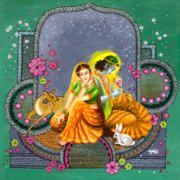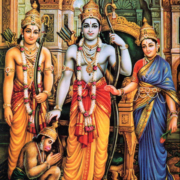The Origin of Paan
By: Mahanidhi Swami
Since today is Mohini Ekadasi, we will tell an interesting story related to the nectar pot. The divine Mohini Shakti of Bhagavan distributed the nectar after the demigods and demons churned the milk ocean. Later from that nectar pot an amazing plant appeared. In the spiritual world, Bhagavan Sri Krishna and His eternal associates regularly chew divine tambula or betel leaf and nuts. These substances are popularly known in India as paan. Many Vaisnavas, as a regulation, do not chew paan or betel nut.
The following English translation of a popular publication of Skanda Purana seems to indicate that chewing paan or betel increases one’s lusty desire which, of course, is unfavorable for anyone serious about self realization. While describing the requisites for preaching yoga, be it dhyana, astanga or bhakti, Bhagavan Sri Krishna says in Bhagavad Gita (6.14), brahmacari-vrate sthitah………….. one must follow the vow of celibacy.
The following entry from Skanda Purana.VI.210 describes the origin of paan:
After churning of the milk ocean, the nectar pot was kept in King Indra’s celestial Nandana Kanana Garden. Airavata accidentally split the pot with the kick of his foot, and out came a creeper with green leaves. Bhagavan Dhanavantri came, named the creeper Nagavalli or ‘betel’ and said, “This betel or paan will be the abode of erotic love, smara. This paan leaf should be combined with betel nut, lime powder and khadira (catechu) and called tambula.”
Later, and earthly king name Vanivatsarak, pleased Lord Indra and got paan as a gift. Due to the power of the paan, the king’s lust increased despite his old age. The king returned to earth, planted the paan leaf and soon it became popular worldwide. Thus ends the story of the origin of paan.
Mohini Ekadasi ki Jai!
Jai Jai Sri Radhe!!








Leave a Reply
Want to join the discussion?Feel free to contribute!